DIET AND EATING HABITS IN JAPAN
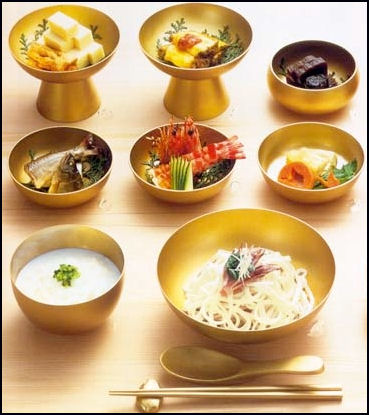
8th century Japanese food Japanese take great pride in the quality and purity of their food. Discussions about food can be very serious, passionate and deeply analytical. Foreign visitors to Tokyo describe the food "sublime, delicate and carefully presented."
The average daily caloric intake in Japan is 2,754 calories, 85th in the world, compared to 3,825 in the United States (no.1) and 1,500 in the Congo (173rd).
Japanese cuisine is often seafood-based and generally it doesn't have the thick spicy sauces associated with Chinese food. Sweet teriyaki-style sauces though are common and artistic arrangements of the food items served is important. Portions are small by American standards and a lot of efforts can go into getting the right ingredients, preparation and presentation, especially at fancy restaurants.
The Japanese love to eat. When asked what makes them happiest, many Japanese say a delicious meal. Television is filled with cooking and eating shows. The variety of food found in Japan is astounding. Hundreds of different dishes are available. Each city, town and region has its speciality for which it is known nationally. But this wasn't always the case. Up until maybe 50 years ago most people ate soup and rice three meal day and occasionally ate dried, salted or fermented dish. Buddhist beliefs discouraged eating of meat and even milk.
Japanese grilling eschews large chunks of meat and big fish. Instead it favor small cuts if meat and small sea creatures that are carefully prepared and cooked. There are often sauces that go with each dish.
It has been said the essence of Western cuisines is richness created by layers of different tastes while the essence of Japanese cuisine is simplicity created by eliminating all unnecessary flavors. The Japanese are obsessed with freshness and food quality. They are willing to pay higher prices for quality.
A survey in 2007 found that 71 percent of foreign tourists to Japan are attracted by Japanese food.
Websites and Resources
Links in this Website: DIET AND EATING HABITS IN JAPAN Factsanddetails.com/Japan ;JAPANESE FOODS AND DISHES Factsanddetails.com/Japan ; FOOD SAFETY IN JAPAN Factsanddetails.com/Japan ; RICE AND NOODLES IN JAPAN Factsanddetails.com/Japan ; SOYBEANS, SOY SAUCE, NATTO, MISO AND TOFU IN JAPAN Factsanddetails.com/Japan ; JAPANESE VEGETABLES, FRUITS AND MUSHROOMS Factsanddetails.com/Japan ; JAPANESE BEEF, MEAT AND DAIRY PRODUCTS Factsanddetails.com/Japan ; SEAFOOD IN JAPAN Factsanddetails.com/Japan ; SUSHI Factsanddetails.com/Japan ; FUGU (BLOWFISH) IN JAPAN Factsanddetails.com/Japan ; RESTAURANTS AND FAST FOOD IN JAPAN Factsanddetails.com/Japan
Good Websites and Sources: Good Photos at Japan-Photo Archive japan-photo.de ; Japanese Food Report Blog japanesefoodreport.com ; Japanese Food Section of Food in Every Country foodbycountry.com ; Japanese Food on Bookmice.net bookmice.net ; Japan Food Diary japanfooddiary.net ; Eat-Japan eat-japan.com ; National Institute of Health and Nutrition nih.go.jp/eiken ; Wikipedia article on Japanese Cuisine Wikipedia ; “ Book: World Food Japan” by John Ashburne (Lonely Planet, 2003) and “The Japanese Kitchen” by Hiroko Shimbo (Harvard Common Press).
Food History: Essay on Food History and National Myths aboutjapan.japansociety.org ; Cambridge World History of Food “ Japan cambridge.org/ ; Minnesota State University e-museum mnsu.edu/emuseum/prehistory/japan/food ; Japanese Diet and Nutrition Diets of the World “ Japan webmd.com/diet/features/diets-of-world-japanese-diet ; Surprising Facts westonaprice.org/Inside-Japan ; Food and Longevity emaxhealth.com ; Fish and Rice in the Japanese Diet japanreview.net ; Eating and Drinking Customs: Essential Japanese Guide essential-japan-guide.com ; Sushi Etiquette homepage3.nifty.com ; Right Way to Eat Sushi snippets.com ;Drinking Customs japanvisitor.com
Japanese Dishes: Good Photos at Japan-Photo Archive japan-photo.de ; About.com on Japanese Food japanesefood.about.com ;Japan Guide japan-guide.com ; Umami Info umamiinfo.com ; Tokyo Food Pages bento.com ; Global Gourmet on Japanese Food globalgourmet.com ; Weird Foods in Japan Incredible Things incrediblethings.com ; Strange and Unusual Chewing Gums inventorspot.com ; From Japan and Beyong sfu.ca/~dashton/food/food ; Weird Food Videos food.3yen.com ; Strange Ice Cream who-sucks.com/food/101-frightening-ice-cream-flavors
Tokyo Restaurants “ The Michelin Guide to Tokyo 2010 “ ”Good Tokyo Restaurants” by Rick Kennedy and “Tokyo Restaurant Guide” by John Kennerdell are a handy resources. Robb Satterwhite's “ Tokyo Food Pages” lists 1,000 places. You can also check lists of restaurants and suggestions in local entertainment magazines, the Lonely Planet books, and other guidebooks. Websites for Tokyo Restaurants Sunny Pages sunnypages.jp ; Tokyo Food Page Bento.com ; Tokyo City Government official site tourism.metro.tokyo.jp Planet Tokyo planettokyo.com
Restaurants in Osaka ” The Michelin Guide Kyoto and Osaka 2010 “ was released in October 2008. Osaka Convention and Tourism Bureau Osaka Info Kansai Restaurant Guide Bento.com ; Restaurants in Kyoto “ The Michelin Guide Kyoto and Osaka 2010 “ was released in October 2008. Restaurant Websites : Kyoto Official Travel Guide by Kyoto Tourism Council Kyoto Travel ; Kansai Restaurant Guide Bento.com ; Kyoto Prefecture Site Welcome to Kyoto ; Kyoto Visitor’s Guide Kyotoguide.com ; Frommers Frommers.com ; Fodors Fodors.com
History of Japanese Food
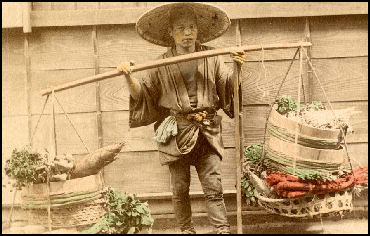
19th century vegetable monger Chopsticks were introduced to Japan from China. Tempura came from Portugal. Deep-frying, stir-frying and combining broiling, grilling and steaming procedures are essential to preparing Japanese foods. These techniques are said to have been introduced to Japan by the Chinese monk Yinyuan Longqi (1592-1673), who founded the last of the three main Japanese Zen sects. Among the foods he introduced that had never been seen in Japan were kidney beans, watermelons and lotus root. His cooking methods were intended to be used on vegetarian dishes and get Japanese to follow Buddhist prohibitions such as not eating meat.
Ideas about the decorative arts made their way into cooking and perfumery. One Edo Period (1603-1867) cookbook illustrates 55 different ways to cut and display carp.
The term Japanese food (“washoku”) didn’t come into existence until the Meiji Period (1868-1912) when it was coined to distinguish indigenous food from Western food (“yoshoku”). Up until that time “Japanese food” was not a single cuisine; it varied a great deal from region to region. Industrialization helped homogenize Japan’s food with hundreds of varieties of locally-produced soy sauces, for example, being replaced by factory-produced national brands.
The militarization of Japan after the Meiji period helped spread food even more and further homogenize eating habits. An effort was made to improve the nutrition of food and raise the energy level (calorie count) to aid the military and some Chinese and Western dishes were introduced to achieve this goal.
Japanese adaptions of Western food — known in Japanese as “yoshoku” — include “naporitan” (ketchup-flavored spaghetti), “omu-raisu” (rice omelet) and “hangug” (hamburger paddy meatloaf with a brown sauce). “Tonkatsu” (pork cutlet”) is an adaption of Veal Cotelet, a French menu item, that was modified because veal gave Japanese heartburn and grated cheese was replaced with breadcrumbs, with the whole thing being deep fried like tempura and served with heaps of shredded raw cabbage. Omu-raisu was developed from leftover restaurant food for the staff to eat. Many of these dished were concocted during the Meiji period at a restaurant in Ginza called Renga-eto that started out as a French restaurant in 1885.
In 2005, Japanese inventor Yoshiro Nakamatsu was given the Ig Nobel peace award in nutritional science for taking photos of every meal he ate for 35 years and analyzing the effects of his off own brain activity.
Japanese Nutrition Quiz
Kate Elwood wrote in the Daily Yomiuri: Several years ago my older daughter Frances brought a bunch of papers home from primary school related to various school events. Among them was something that appeared to be a simple game, in which the respondent proceeded forward from square to square, based on whether the answer to the previous question was "yes" or "no." So we gave it a go. It soon became clear that it had been created as an entertaining way to get the young students to think about the importance of breakfast. It also soon became clear that my daughter and I were not up to snuff when it came to the morning meal, according to the game, which no longer seemed quite so fun. [Source: Kate Elwood, December 13, 2011]
We started out OK, with the question "Do you eat breakfast every morning?" But we were shot down by the very next question, "Do you eat rice for breakfast?" and brusquely shunted off to the side of the quiz for morning sluggards. Frances took it in stride, but I found myself falling into my most "I beg to differ" sarcastic mode, never a very lovely sight. Whole wheat toast, an egg and salad, and we were designated breakfast rejects? It gave a whole new perspective on the expression "You're toast!"
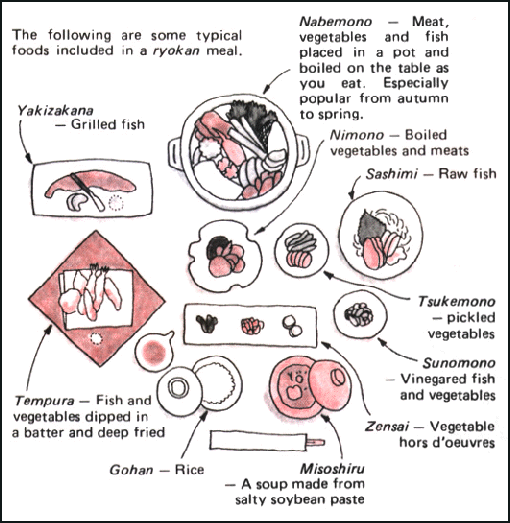
typical Japanese meal
Meals in Japan
A traditional meal is served with rice, vegetables and miso (fermented soy bean paste) soup and fruit is often eaten as desert. Many dishes come with soy sauce or wasabi (very hot mustard-like green horseradish). Many urban Japanese have adopted the American way of eating — a big breakfast, light lunch, and a big dinner. Miso soup and rice are a dietary base, often eaten for breakfast, lunch, and dinner.
Breakfast (asa-gohan) is generally eaten between 7:00am and 7:30am and consists of juice, coffee, eggs and toast or rice. A typical breakfast consists of rice, miso soup, spinach and egg. Most people eat breakfast at home. It's hard to find a restaurant that serves breakfast. Many coffee ships have a set breakfast with a drink, toast, boiled egg and light food. On the weekends people eat pancakes or a traditional breakfast of miso soup, rice, egg, vegetable and fish.
Lunch (hiru-gohan) is generally eaten between 12:00 noon and 2:00pm. Many people eat out, grabbing a quick meal or snack such as a bowl of noodles, sandwiches, rice balls or Chinese food.
Dinner (ban-gohan) is generally eaten between 6:00pm and 8:00pm. It generally an informal meal with meat or fish, rice and miso soup. Main dishes made at home, include thing things like curry rice, pork cutlets, meatloaf-like hamburgers, fried fish, stir fried chicken or pork dishes, and dishes made with tofu. Fancier dinners include some of the items listed below.
Japanese often drink nothing with their meals, Miso soup often serves the purpose of a drink. Sometimes beer, wine, hot tea, cold tea, water or other drinks are served with their meals. An evening snack of fruit is commonly eaten around 10:00pm.
Eating Customs in Japan
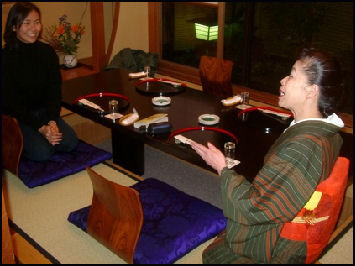
Meals prepared in traditional Japanese style are served on low tables set up on the floor. People sit on the floor and don't start eating until the oldest male or someone says lets eat and everybody says “itaeakimas”.” When offering a plate, dish, glass or bottle to someone who is older than you, you show respect by using two hands to present the object.
Japanese generally don't use napkins. At restaurants, customers are served hot towels, which sometimes can be used like a napkin. At home people sometimes use tissues. In any case, it is good idea to have your own tissues handy in case you need one. Many Japanese carefully fold their towel or tissue after finishing their meal rather than wadding it up.
Sometimes Japanese don't drink anything with a meal. Sometimes water or green tea is served. Often a soup serves the same purpose as a drink. It is served in a lacquered bowl which is picked up and sipped like a drink. Items in the soup are picked out with chopsticks. A spoon is not used. The Japanese also tend to eat their rice separately from the main dish. They often take one bite of rice and then one bite of the main dish so it mixes in their mouth.
Eating Don'ts in Japan
Japanese consider it uncouth to lick your fingers or blow your nose, especially when eating. Japanese are offended if you dump soy sauce or salt all your food. They regards this as an efforts to mask the flavor of food that taste bad. If you use a toothpick cover your mouth while you do it. Also remember that an empty rice bowl if often a sign that you have finished eating.

Japanese consider it somewhat rude to eat in front of non-eating people, or to eat while walking down the streets. The latter custom dates back to a time when eating in public was considered mean to people who didn't have enough to eat. In 8th century Japan there was a law that required anyone caught in the act of drinking while standing up to commit suicide. With the rising popularity of fast food, many people now eat on the streets on subways. Eating on trains is the norm.
Slurping in Japan
Japanese often make loud slurping noises when eating noodles. Making noise is not considered impolite, rather, it is considered a compliment and an expression of enjoying the food. One man told AP, "It'll be a truly lonely feeling when nobody makes slurping noises anymore." In some situations, a particularly loud slurp means you've finished eating.
Many Japanese, especially older men, believe that noodles taste better when they hot and drenched in broth and are best appreciated when slurped. Among the ranks of unapologetic noodle slurpers are Prime Minister Junichito Koizumi.
Sometimes a well-timed burp is also taken as a compliment.
These days many Japanese, especially young women find noodle slurping noises to be offensive and worry about splattering broth on their designer clothes. "Slurping is for old men," one office worker told AP. "Slurping has nothing to do whether it taste good or not."
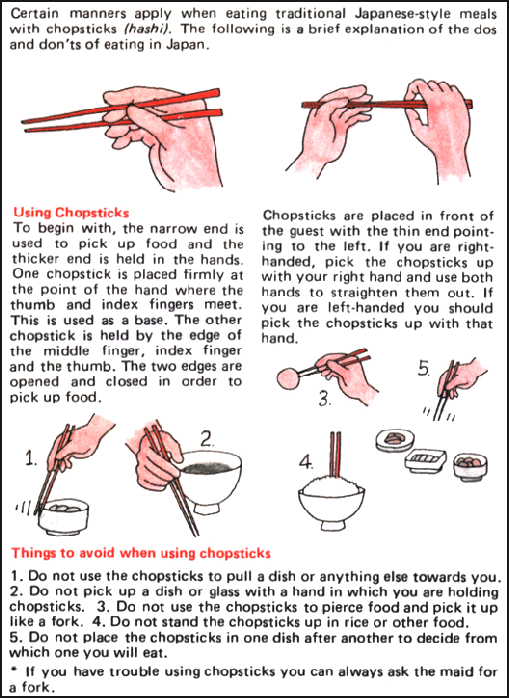
Chopsticks, Servings and Dishes in Japan
Japanese eat all Japanese-style meals with chopsticks. Even soup is consumed with chopsticks (the ingredients are eaten with chopsticks and the soup is drunk from the bowl). Many Japanese pick up their rice bowl when they are eating and place it under their mouths and use it as a safety net for anything that falls down. When a rice bowl isn't available they place their free hand under their chopsticks for the same purpose. Leaving chopsticks sticking up in a bowl of rice should be avoided. It is a sign of death. Most food is soft or small enough that it can picked up or cut with chopsticks. Forks, knives and spoons are used for eating Western food.
Japanese prefer disposal wooden chopsticks at restaurants and laminated wooden ones at home. Vietnamese often use plastic chopsticks while Korean tend to use metal ones for food dishes and a sppon for rice. In Japan, when you finish you using your chopsticks you should set your chopsticks in a little chopstick tray or place them horizontally on your plate or bowl in such a way that they are not pointing at anyone. If you forget some of these rules or get mixed up it is usually no great tragedy.
Meals often consist of many dishes, which are passed around and carried from the kitchen on trays and placed in the table. Each person serves himself some food from the dishes onto small plate. Sometimes there are different plates for different foods.
Ideally you should serve yourself with one set off chopsticks and eat with another. People often serve themselves by taking food from a serving dish with a serving spoon, their fingers or communal chopsticks and then placing them on a small plate in front of them. If there is no serving spoon or communal chopsticks, you should turn your chopsticks around and pick up the food with the end of your chopsticks that have not been placed in your mouth.
Eating Habits in Japan

Household expenditure on food: 16 percent (compared to 50 percent in Ethiopia and 13 percent in the United States). The average Japanese adult consumes 2887 calories a day (compared to 3603 calories per adult in the United States and 1991 calories in Kenya). Grains make up 40.7 percent of the diet, compared to 24.8 percent in the United States.
The traditional Japanese diet is made up of fish, rice, pickles, miso soup and vegetables served in small healthy proportions. In the old days the Japanese didn’t eat meat or milk products. These food became more popular when Western influences began to take hold and spread as the income of ordinary people rose and they could afford more foreign food. Many food introduced from outside Japan have been greatly altered to suit local tastes. “Tonkatsu”, for example, is a fried pork cutlet adapted so it can be eaten with chopsticks rather than a knife and fork.
According to an informal survey by the authors of the book “The Hungry Planet”, a typical family of four in Kyoto spends $317.25 a week on food, including $31.55 on grains and other starchy food; $2.26 on dairy products; $99.80 on meat, fish and eggs; $81.43 on fruits, vegetables and nuts; $28.28 on condiments; $15.33 on snacks and desserts; $21.78 on prepared foods; $28.40 on beverages; and $8.42 for miscellaneous.
Small portions are a hallmark of Japanese eating habits. Children are taught feel satisfied without feeling stuffed, ascribing to the saying, “Fill your stomach only 80 percent.” Habits such as eating from a rice bowl and taking food from shared bowls cut down in consumption. Paul Yamaguchi, author of several books on Japanese nutrition told the U.S. News and World Report, “We don’t put everything on one plate, so what’s in front of you is much smaller.”
The average Japanese consumes 200 fewer calories a day than the average American, with a large order of McDonald’s fries in Japan having 529 calories, compared to 570 in the United States. Naomi Moriyama. Author of “Japanese Women Don’t Get Old or Fat”, told U.S. News and World Report, “Food is never served to the rim or the edges o the plate...I’d rather have a small amount that tastes amazing then belly-busing amount that doesn’t taste good.”
One survey found that 60 percent of Japanese value eating together as a family. Another survey found that 63 percent of Japanese spend less than 15 minutes eating breakfast.
Changing Eating Habits in Japan

Many urban Japanese have adopted the American way of eating — a big breakfast, light lunch, and a big dinner. Some people attribute this phenomena and a fattier diet to an increase in heart disease among Japanese and an increase in obesity. A government survey in 2002, found that 30 percent of men between 30 and 60 are obese, an increase of 40 percent from two decades earlier.
Although fish, vegetables and rice remain the staples of the Japanese diet, Japanese are increasingly eating more sweet, fatty and calorie-rich food as reflect by the popularity of Haagen Daz ice cream, Krispy Kreme doughnuts and four-patty Megamac burgers. Food writer Mei Hojo wrote in “Super Calorie recipes”, “People aren’t satiated. That’s why they are going for doughnuts and ice cream. It’s a search for satiation.”
Consumption of rice and fresh fruit has declined by half since 1970, while beef consumption has risen by 40 percent and coffee drinking has tripled in the same period of time. Fish consumption dropped around 15 percent in the 1990s, largely because it was difficult to prepare, while the purchase of prepared foods increased 65 percent in the same period. During the Bubble Economy years there was a fascination with gourmet food followed by an interest in health food and diet.
Busy children attending after school classes are reportedly eating more and more starchy food, frozen microwave snacks, convenience store sandwiches, cup of noodles and rice balls Many salarymen eat almost exclusively at convenience stores. Shops that sell crepes and Belgian waffles are a common sight at shopping areas.
In a 2010 TV Tokyo television show, Wm. Penn wrote in the Daily Yomiuri, in supermarket interview s “women who recited the importance of feeding their families nutritious food...squirmed with embarrassment when asked what they had for lunch or what they had in their shopping carts.” At the home of one woman “the TV Tokyo cameras...watched her in the kitchen microwaving packaged foods and opening convenience store containers. She did invest some effort arranging the pre-cooked food attractively on the plate with lemon slices and cherry tomato garnishes.” [Source: Wm. Penn, Daily Yomiuri Shimbun, November 2010]
The show, “ Shin Nipponjin no Shokutaku “, “also looked at how the prepared food industry is assisting in this deception by making their products taste more like “ofukuro no aji” (mom’s home cooking) and how dining habits have devolved to eating out of the pot or grabbing foods that do not require even chopsticks to eat...So who was to blame? Lazy mothers, a busy, overworked society with no time to cook, the readily available plastic-encased cuisine pushed by the packaged food industry or even that all-too-convenient invention — the microwave — ...No the show’s conclusion was to blame it all on grandmas and democracy,” arguing that young wives in 1970s who were first exposed instant ramen and processed food failed to teach their daughters to cook, leaving them without the discipline to resist the convenience-oriented market place. “
More Japanese Shunning Traditional Diet, Table Manners
Japanese people are gradually moving away from traditional food and table manners, according to a study by Tokyo Gas Co.'s Urban Life Research Institute, which conducted surveys on food habits on about 3,300 respondents in their 20s to 80s in the Tokyo metropolitan area in 1990 and 2011. The study's results showed that in 2011, 65 percent of respondents said they wanted to eat miso soup at least once a day, down from 77 percent in 1990. In the 2011 survey, less than 50 percent of respondents in their 20s said so. Asked whether they mainly ate rice or bread for breakfast, 34 percent said rice in the 2011 survey, compared to 44 percent in 1990. The percentage of respondents who ate bread or cereal for breakfast rose to 40 percent in 2011, compared to 35 percent in 1990. [Source: Yomiuri Shimbun, May 3. 2012]
"Washoku,or traditional dietary culture, which includes how food is served and table manners, may be disappearing from Japanese tables," said Nobuko Iwamura, an official at Asatsu-DK Inc., an advertising firm that has been conducting studies on Japanese eating habits since 1998. The studies covered families raising children with mothers born in 1960 and after. Participants were asked to keep track of their meals by taking pictures or keeping a diary for one week.
Traditionally in Japan, family members sit together to eat a meal consisting of rice as a staple, three dishes and a bowl of soup. However, the studies revealed that reality is far from this ideal. For example, some respondents ate only snacks or cookies for breakfast, while others said they prepared dinners consisting primarily of carbohydrates, such as sandwiches and fried yakisoba noodles served together. In other cases, aluminum foil was used instead of dishes, and some children could not use chopsticks properly. Instead of eating together, family members ate what they wanted and at different times.
In an effort to preserve traditional Japanese food culture, some schools and local communities have started promoting dietary education and encouraging people to eat locally produced food.
Diet and Health in Japan
Good food and good eating is equated with good health and a happy family life in Japan. Both home cooking and meal times, seen as “occasions for family communications,” are valued. Fish, rice and seaweed are important staples, vegetable oil is preferred over animal fat.
“Shokuiku” (“teaching the importance of healthy eating”) is stressed in classrooms on primary and middle school. Eating guidelines recommend consuming “30 different foodstuffs,” with an emphasis on fruit and vegetables, each day.
In May 2006, scientists at Tohuku University in Japan concluded that a traditional Japanese, fish-based, low-fat diet is healthier than an American diet based on a study in which 21 typical foods from each country were freeze dried, ground into powder and then fed to eight mice for a period of three weeks. American food items including hamburgers and fried chicken while Japanese items included sashimi and rice porridge. Mice fed Japanese food had lower cholesterol levels and recorded higher activity among genes that break down cholesterol.
Fat accounts for less than 20 percent of the calories in the Japanese diet, compared to nearly 40 percent in the American diet. Advanced tumors are six times more likely in the United States than n Japan. Japan has a low fiber intake and a high constipation rate compared to other countries.
A study by a team led by Akiko Nanri of the National Center for Global Healthy published in the European Journal of Clinical Nutrition found that people who ate a healthy Japanese diet exhibited symptoms of depression half as often as those who do not.
McDonald’s and Seven & I, which runs Seven Eleven convenience stores, in Japan are trying to eliminate or reduce trans fats in their products.
Seafood Diet and Health in Japan
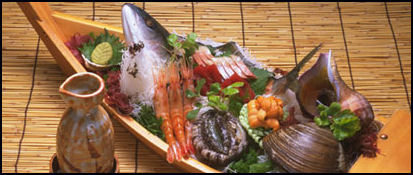
The Japanese have traditionally eaten a lot of fish. In 2000, the American Heart Association recommended that people eat salmon or tuna twice a week. It was the first time the group recommended eating specific things rather than offering general guidelines. Studies have shown that eating oily fish can significantly reduce the chances of getting a stroke, developing prostrate or breast cancer, suffering from depression or being stricken by a sudden, unexpected death caused by a severely abnormal heart rhythms.
Eating fish has been linked with low cholesterol levels and low rates of heart disease. Oily fish such as salmon and tuna are in rich fish oils, which in turn are rich in omega-3 fatty acids, an essential nutrient in the human diet. There is evidence that omega-3 fatty acids prevent inflammation, clot formation and clogging of blood vessels with fat and cholesterol and that a lack of omega-3 fatty acids may play a role in a variety of maladies, including bipolar disorder, heat arrhythmia, high blood pressure, heart disease, kidney failure, irritable bowel syndrome and rhomboid arthritis.
Omega-3 and omega-6 are essentially fatty acids that work together to promote good health, The human body can not make them so it is essential that people eat diet rich in them. Omega-3 are found in fish and certain oils such as canola and flaxseed and omega-6 are found in raw nuts and seeds. Omega-3 fatty acids are found in sardines, salmon, herring and some kinds of tuna. Shrimp, some kinds of tuna, haddock, clams, cod, and crab are low in Omega 3s. Omegas 3s are also found in wild game, nuts like almonds and walnuts and avocados. With the absence of Omega-3s the body uses saturated fat to make cell membranes. Cell membranes made with this type of fat are less elastic and a lack of elasticity can be dangerous to the heart.
Studies have also shown that eating fish rich in omega-3 fatty acids cuts the risk of stroke and cancer. A Finnish study published in the journal Neurology in August 2008, researchers found that older adults who regularly ate fish had a lower chance of developing subtle brain damage that contributed to stroke and dementia. A study by Dr. Mich Brown of Paterson Institute at Christie Hospital in Manchester England published in the journal Cancer in March 2006 found that eating foods rich omega-3 fatty acids could help prevent the spread of prostrate cancer.
Eating fish can reduce irregular heart beats. In a study conducted by Bingham and Women’s Hospital and Harvard Medical School, regularly eating tuna or broiled or baked — but not fried — fish reduces the risk of atrial fibrillation, a major cause of stroke and other problems. Scientists credit the Omega 3s in the fish.
There is also some research that suggests that mothers who eat Omega 3s while pregnant produce smarter children and that people who get angry easily can better control their tempers better if they eat them. A study by American and British researchers published in Lancet in 2007 reported that children of mothers who ate small amounts of fish when they were pregnant gave birth to children who had lower IQ and academic test scores and had more social and behavioral problems than children of mothers who ate 12 or more ounces of fish per week. Other studies have indicated that women who don’t get enough omega-3 fatty acid are more likely to deliver babies too early and at a low birth weight.
'Enlarged' Food Fools Dieters into Feeling Full
In April 2012, the Yomiuri Shimbun reported: “A team of researchers has developed a new approach to dieting--controlling your appetite by viewing an enlarged image of a food item you are about to eat. The team, led by University of Tokyo Prof. Michitaka Hirose, has developed an image processing system that changes the apparent size of a food item when one picks it up to eat it. The size of the user's hand appears unchanged. [Source: Yomiuri Shimbun, April 11, 2012]
The system involves a pair of eyeglasses equipped with video cameras connected to a computer that processes the images. When a person wearing the glasses looks at a food item he or she is holding, the system processes the image of the item to make it appear as much as 50 percent larger or 33 percent smaller than actual size. It also processes images of the hand so it looks natural even while holding the different-sized items.
The team conducted an experiment using the system, in which 12 men and women in their 20s and 30s were asked to eat cookies until they got full. When the image processing system showed cookies 50 percent larger than actual size, the test subjects ate 9.3 percent less on average compared to the amounts they ate while viewing the cookies with their naked eyes. In contrast, when the system showed cookies 33 percent smaller than actual size, the people ate 15 percent more on average, according to the team.
Unhealthy Food and Japan
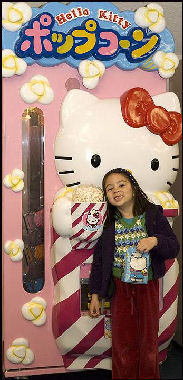
Hello Kitty popcorn Almost the entire population of Japan has high methymercury levels — thought to have come from tuna and other fish — that are above U.S. Environmental Protection Agency limits but seem no worse for the wear.
The obesity rate in Japan is 3.6 percent compared ro 32 percent in the United States.
When Japanese move to the West their rates of chronic diseases like diabetes and heart disease go up. Some linked the trend to the eating of more meat and less soy bean products,
Changing eating habits — namely consuming more meat, cheese and fat-rich Western foods — has been accompanied by higher cholesterol levels and rates of heart disease and other illnesses. There are currently 8.2 million Japanese with diabetes, double the number in the early 1990s. The rate is expected to reach 10 million in the next ten years and become a strain on the national health care system.
Sharp has developed a microwave-oven-size oven that it claims blasts the fat and salt out of food with superheated steam. Costing about a $1,000, the oven uses a generating unit to produce intense 300̊C steam that is blasted at the food in three directions, reducing fat and salt, when the the liquid is drained away. Sharp maintains that the oven can cook a steak and reduce its fat content by a factor of eight and can make it “taste better.”
Metabolic Syndrome in Japan
A big deal is made in Japan about metabolic syndrome — a grouping of risk factors for developing heart attacks, and cardiovascular disease and diabetes that includes high cholesterol, high blood pressure, elevated triglyceride levels, high glucose levels, low levels of “good” HDL cholesterol and abdominal obesity — after a study found that half of all men between the age of 40 and 74 and one in five women show signs of it. In some places people are diagnosed with the condition based solely on their waist size regardless of their height and weight.
The report shocked the nation and the government responded with legislation to identify “metab” and get Japanese to get in better shape and encouraged Japanese companies to get involved. One regulation that took affect in April 2008, required all citizens over the age of 40 to have their waists measured with men with waists exceeding 33.5 inches and women with waists over 35.5 inches considered at risk and referred to counseling and close monitoring.
As part of the regulations companies are required to slim down their workforce or pay high insurance premiums. In response some companies have begun offering employees deliveries of healthy foods like brown rice, started offering “lifestyle instruction courses, offering “healthy menus” in company cafeterias to their homes and begun sponsoring retreats for overweight employees to help them trim down with lectures on diet, exercise and Zen mediation.
A number of products have been introduced to help people slim and lose weight. Among the most popular are devices that count how far a person walks everyday and calculates what their caloric intake should be.
The practice of determining whether someone has metabolic syndrome based solely on measuring waist size has been called into question. Also, an increase in metabolic syndrome tests has come at the expense of cancer testing. One survey has shown that has the number of people getting metabolic syndrome tests has increased the number getting cancer tests has shrunk.
Easing Freshness Regulations to Stop Good Food Going to Waste
According to an estimate by the Agriculture, Forestry and Fisheries Ministry, 5 million tons to 8 million tons of food is scrapped yearly because it was returned or for other reasons. According to an estimate by the Distribution Economics Institute of Japan, the amount of processed food returned to manufacturers totaled ¥113.9 billon ($1.6 billion) in fiscal 2010, about 1 percent of the total value of shipments. In addition, significant amounts of food awaiting shipment are discarded because the delivery deadline passes.
Sachio Tanaka and Yukiko Furusawa wrote in the Yomiuri Shimbun: “A team of food manufacturers, wholesalers and retailers has begun reviewing distribution practices so they can relax rules on freshness in an attempt to reduce waste. The team is planning to revise eat-by freshness dates and the so-called one-third rule on food delivery. The one-third rule refers to processed foods that must reach retailers in one-third or less of the time it takes from production to the eat-by freshness date. The remaining two-thirds of that time are considered the sales period. It is believed this practice spread throughout the nation in the 1990s under the initiative of supermarket chains. [Source: Sachio Tanaka and Yukiko Furusawa, Yomiuri Shimbun, November 7, 2012]
The Economy, Trade and Industry Ministry formed a council in October 2012 comprising 40 major makers, wholesalers and retailers in an effort to eliminate waste and streamline distribution. The council agreed to ease the one-third rule. One participant said: "After the Great East Japan Earthquake, consumer awareness has changed. They tend to have strong feelings against wastefulness." Another participant said, "Every industry should make efforts to win more understanding on eat-by freshness dates from consumers by cooperating with each other.”
The team plans to study how the one-third rule is applied and how to ease standards in cooperation with the council. The team also plans to propose flexible rules by introducing appropriate item-by-item delivery deadlines. For companies suffering recent economic slumps, the cost of returning and disposal of food is a heavy burden. "There're many small and midsized companies in a vulnerable position. Most of them have been victims of unreasonable demands from retailers," said an official of a confectionery maker, which hopes the one-third rule will be changed.
Meanwhile, some retailers are calling for accurate production adjustments. "Excess production also is a problem. It's necessary to accurately adjust production as well as reviewing the [one-third] rule," an official of a midsized supermarket chain said.
NonProfit Group Uses Food Destined to be Thrown Out
Sachio Tanaka and Yukiko Furusawa wrote in the Yomiuri Shimbun: “Corrugated boxes filled with processed food such as instant noodles, canned food and confectionery were piled in a corner of a building in Tokyo. The food, which was originally to be disposed of, was provided by food manufacturers and other firms to a nonprofit organization, Second Harvest Japan. The NPO's staff sort the food and then send it to orphanages and other organizations. [Source: Sachio Tanaka and Yukiko Furusawa, Yomiuri Shimbun, November 7, 2012]
About 80 percent of the food is sent to the NPO because it is approaching its best-before dates. But most of the food has more than one month remaining on its best-before dates. Some canned food even has more than one year remaining, and there is no problem with the quality of the food.
In 2011, Second Harvest Japan received 1,689 tons of food, including perishables."The food being sent here is only a fraction of what's available. A large amount of edible food is discarded," said Rumi Ide, a Second Harvest Japan official. The reason for this is that food, which has not reached its best-before date, is returned to food manufacturers in accordance with the one-third rule.
Image Sources: 1) Liza Dahlby 2) Visualizing Culture, MIT Education 3) 5) 8), JNTO, 4) Andrew Gray Photosensibility 6) Phil Haak 7) and 11) Ray Kinnane, 9) Photomann, 10) Strange ad Funny News blog
Text Sources: New York Times, Washington Post, Los Angeles Times, Daily Yomiuri, Times of London, Japan National Tourist Organization (JNTO), National Geographic, The New Yorker, Time, Newsweek, Reuters, AP, Lonely Planet Guides, Compton’sEncyclopedia and various books and other publications.
Last updated January 2013
